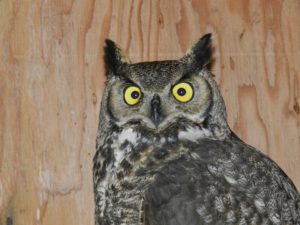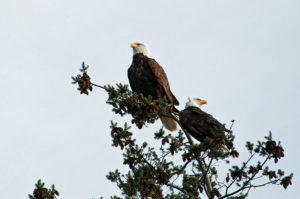A recent visitor to Zylstra Lake Preserve alerted us to a Bald Eagle’s nest she spotted during her walk, so we checked in with Shona Aitken, Education Coordinator at Wolf Hollow Wildlife Rehabilitation Center on what to expect as spring emerges around us, and tips for observing our feathered friends with care.
Early Nesters – It may not seem like spring to us, and it will be a few weeks before many of the local songbirds start nesting, but some birds such as Great Horned Owls and Bald Eagles have already begun.  These larger birds incubate their eggs for a longer period and their youngsters take longer to grow and develop, so they get started on the whole process much earlier. You may have heard deep hoots echoing back and forth through the forest way back in January or even December when Great Horned Owls started pairing up. By February they often have eggs in the nest that will be hatching very soon.
These larger birds incubate their eggs for a longer period and their youngsters take longer to grow and develop, so they get started on the whole process much earlier. You may have heard deep hoots echoing back and forth through the forest way back in January or even December when Great Horned Owls started pairing up. By February they often have eggs in the nest that will be hatching very soon.  Bald Eagles have been doing their wheeling courtship displays for weeks. Now they’re refurbishing their huge stick nests and often start laying their eggs in late February or early March. In these early stages these nesting birds can be easily disturbed by activities nearby, so it’s good to remember these early nesters when you’re planning work in your forest.
Bald Eagles have been doing their wheeling courtship displays for weeks. Now they’re refurbishing their huge stick nests and often start laying their eggs in late February or early March. In these early stages these nesting birds can be easily disturbed by activities nearby, so it’s good to remember these early nesters when you’re planning work in your forest.
Photos courtesy of Wolf Hollow Wildlife Rehabilitation Center

